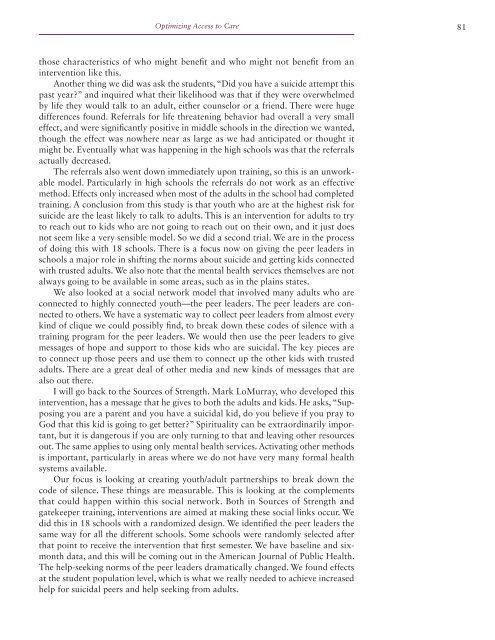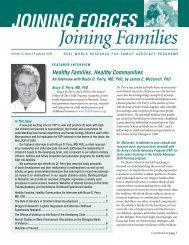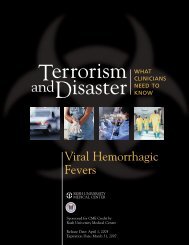stigma and barriers to care - Uniformed Services University of the ...
stigma and barriers to care - Uniformed Services University of the ...
stigma and barriers to care - Uniformed Services University of the ...
Create successful ePaper yourself
Turn your PDF publications into a flip-book with our unique Google optimized e-Paper software.
Optimizing Access <strong>to</strong> Care 81<br />
those characteristics <strong>of</strong> who might benefit <strong>and</strong> who might not benefit from an<br />
intervention like this.<br />
Ano<strong>the</strong>r thing we did was ask <strong>the</strong> students, “Did you have a suicide attempt this<br />
past year” <strong>and</strong> inquired what <strong>the</strong>ir likelihood was that if <strong>the</strong>y were overwhelmed<br />
by life <strong>the</strong>y would talk <strong>to</strong> an adult, ei<strong>the</strong>r counselor or a friend. There were huge<br />
differences found. Referrals for life threatening behavior had overall a very small<br />
effect, <strong>and</strong> were significantly positive in middle schools in <strong>the</strong> direction we wanted,<br />
though <strong>the</strong> effect was nowhere near as large as we had anticipated or thought it<br />
might be. Eventually what was happening in <strong>the</strong> high schools was that <strong>the</strong> referrals<br />
actually decreased.<br />
The referrals also went down immediately upon training, so this is an unworkable<br />
model. Particularly in high schools <strong>the</strong> referrals do not work as an effective<br />
method. Effects only increased when most <strong>of</strong> <strong>the</strong> adults in <strong>the</strong> school had completed<br />
training. A conclusion from this study is that youth who are at <strong>the</strong> highest risk for<br />
suicide are <strong>the</strong> least likely <strong>to</strong> talk <strong>to</strong> adults. This is an intervention for adults <strong>to</strong> try<br />
<strong>to</strong> reach out <strong>to</strong> kids who are not going <strong>to</strong> reach out on <strong>the</strong>ir own, <strong>and</strong> it just does<br />
not seem like a very sensible model. So we did a second trial. We are in <strong>the</strong> process<br />
<strong>of</strong> doing this with 18 schools. There is a focus now on giving <strong>the</strong> peer leaders in<br />
schools a major role in shifting <strong>the</strong> norms about suicide <strong>and</strong> getting kids connected<br />
with trusted adults. We also note that <strong>the</strong> mental health services <strong>the</strong>mselves are not<br />
always going <strong>to</strong> be available in some areas, such as in <strong>the</strong> plains states.<br />
We also looked at a social network model that involved many adults who are<br />
connected <strong>to</strong> highly connected youth—<strong>the</strong> peer leaders. The peer leaders are connected<br />
<strong>to</strong> o<strong>the</strong>rs. We have a systematic way <strong>to</strong> collect peer leaders from almost every<br />
kind <strong>of</strong> clique we could possibly find, <strong>to</strong> break down <strong>the</strong>se codes <strong>of</strong> silence with a<br />
training program for <strong>the</strong> peer leaders. We would <strong>the</strong>n use <strong>the</strong> peer leaders <strong>to</strong> give<br />
messages <strong>of</strong> hope <strong>and</strong> support <strong>to</strong> those kids who are suicidal. The key pieces are<br />
<strong>to</strong> connect up those peers <strong>and</strong> use <strong>the</strong>m <strong>to</strong> connect up <strong>the</strong> o<strong>the</strong>r kids with trusted<br />
adults. There are a great deal <strong>of</strong> o<strong>the</strong>r media <strong>and</strong> new kinds <strong>of</strong> messages that are<br />
also out <strong>the</strong>re.<br />
I will go back <strong>to</strong> <strong>the</strong> Sources <strong>of</strong> Strength. Mark LoMurray, who developed this<br />
intervention, has a message that he gives <strong>to</strong> both <strong>the</strong> adults <strong>and</strong> kids. He asks, “Supposing<br />
you are a parent <strong>and</strong> you have a suicidal kid, do you believe if you pray <strong>to</strong><br />
God that this kid is going <strong>to</strong> get better” Spirituality can be extraordinarily important,<br />
but it is dangerous if you are only turning <strong>to</strong> that <strong>and</strong> leaving o<strong>the</strong>r resources<br />
out. The same applies <strong>to</strong> using only mental health services. Activating o<strong>the</strong>r methods<br />
is important, particularly in areas where we do not have very many formal health<br />
systems available.<br />
Our focus is looking at creating youth/adult partnerships <strong>to</strong> break down <strong>the</strong><br />
code <strong>of</strong> silence. These things are measurable. This is looking at <strong>the</strong> complements<br />
that could happen within this social network. Both in Sources <strong>of</strong> Strength <strong>and</strong><br />
gatekeeper training, interventions are aimed at making <strong>the</strong>se social links occur. We<br />
did this in 18 schools with a r<strong>and</strong>omized design. We identified <strong>the</strong> peer leaders <strong>the</strong><br />
same way for all <strong>the</strong> different schools. Some schools were r<strong>and</strong>omly selected after<br />
that point <strong>to</strong> receive <strong>the</strong> intervention that first semester. We have baseline <strong>and</strong> sixmonth<br />
data, <strong>and</strong> this will be coming out in <strong>the</strong> American Journal <strong>of</strong> Public Health.<br />
The help-seeking norms <strong>of</strong> <strong>the</strong> peer leaders dramatically changed. We found effects<br />
at <strong>the</strong> student population level, which is what we really needed <strong>to</strong> achieve increased<br />
help for suicidal peers <strong>and</strong> help seeking from adults.




